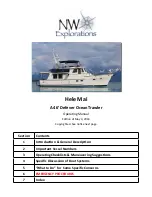
CHAPTER 3
PROPULSION SYSTEM
- 12 -
29z
3.2 COOLING
Your engine passes seawater (raw water) from the intake on the sterndrive, through a heat
exchanger where it cools the engine’s coolant. This coolant is circulated through the engine and
returns to the heat exchanger. For the engine to keep cool, it must have an adequate supply of
raw water and coolant. Before starting check the seawater filter and the coolant level. .
Do not attempt to remove the coolant cap of a hot engine.
For details on what type of coolant to use, consult the Volvo operator’s manual or the
maintenance schedule included in this manual..
3.3
NEW ENGINE BREAK-IN
On the initial engine start-up, check for proper engine oil pressure, diesel fuel leaks, engine oil
leaks, coolant leaks, proper operation of the indicators and gauges, proper exhaust color, engine
vibrations and sounds, adequate seawater discharge from the exhaust.
The engine must be run-in for its first 10 operating hours as follows: Operate the engine normally.
Do not operate at full load except for short periods. Never run the engine at a constant speed for
long periods during the running-in period.
The engine can be expected to use more engine oil during the running-in period than would
otherwise be normal.
Carefully observe oil pressure and engine temperature and check engine oil and coolant levels
frequently.
3.4
LUBRICATION (See Volvo D4 Engine Manual)
Both the engine and transmission (reverse gear) use oil for lubrication. The transmission will tend
to use less oil than the engine, but both should be checked frequently. For the proper type of oils
to use (which may depend on the service area and conditions) consult the maintenance schedule.
The engine oil may be checked on either side by pulling the red dipstick on the port top of the
engine The transmission dipstick is red.
Sea Water Filter
Check & Cleaned
Racor Fuel pre-Filter
Engine Oil Dipstick
Check Level
Coolant Checked
here to be between
MAX & MIN













































